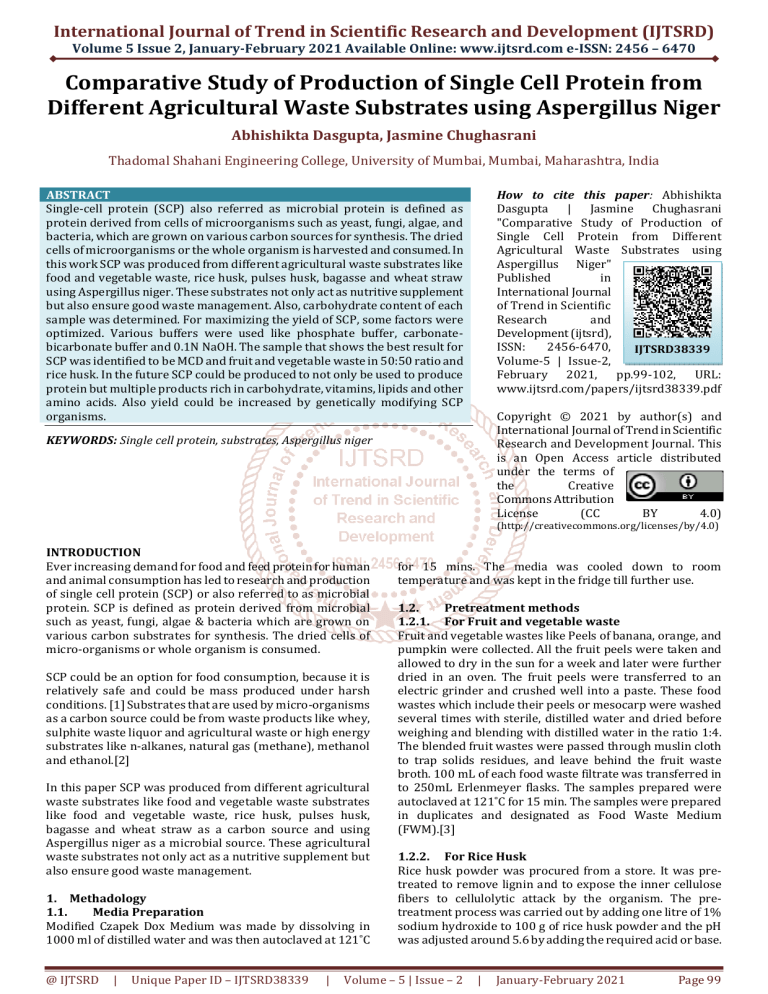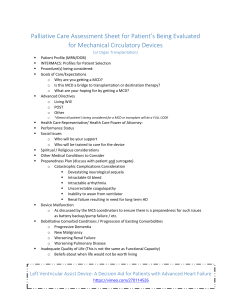
International Journal of Trend in Scientific Research and Development (IJTSRD)
Volume 5 Issue 2, January-February 2021 Available Online: www.ijtsrd.com e-ISSN: 2456 – 6470
Comparative Study of Production of Single Cell Protein from
Different Agricultural Waste Substrates using Aspergillus Niger
Abhishikta Dasgupta, Jasmine Chughasrani
Thadomal Shahani Engineering College, University of Mumbai, Mumbai, Maharashtra, India
How to cite this paper: Abhishikta
Dasgupta | Jasmine Chughasrani
"Comparative Study of Production of
Single Cell Protein from Different
Agricultural Waste Substrates using
Aspergillus Niger"
Published
in
International Journal
of Trend in Scientific
Research
and
Development (ijtsrd),
ISSN:
2456-6470,
IJTSRD38339
Volume-5 | Issue-2,
February 2021, pp.99-102, URL:
www.ijtsrd.com/papers/ijtsrd38339.pdf
ABSTRACT
Single-cell protein (SCP) also referred as microbial protein is defined as
protein derived from cells of microorganisms such as yeast, fungi, algae, and
bacteria, which are grown on various carbon sources for synthesis. The dried
cells of microorganisms or the whole organism is harvested and consumed. In
this work SCP was produced from different agricultural waste substrates like
food and vegetable waste, rice husk, pulses husk, bagasse and wheat straw
using Aspergillus niger. These substrates not only act as nutritive supplement
but also ensure good waste management. Also, carbohydrate content of each
sample was determined. For maximizing the yield of SCP, some factors were
optimized. Various buffers were used like phosphate buffer, carbonatebicarbonate buffer and 0.1N NaOH. The sample that shows the best result for
SCP was identified to be MCD and fruit and vegetable waste in 50:50 ratio and
rice husk. In the future SCP could be produced to not only be used to produce
protein but multiple products rich in carbohydrate, vitamins, lipids and other
amino acids. Also yield could be increased by genetically modifying SCP
organisms.
Copyright © 2021 by author(s) and
International Journal of Trend in Scientific
Research and Development Journal. This
is an Open Access article distributed
under the terms of
the
Creative
Commons Attribution
License
(CC
BY
4.0)
KEYWORDS: Single cell protein, substrates, Aspergillus niger
(http://creativecommons.org/licenses/by/4.0)
INTRODUCTION
Ever increasing demand for food and feed protein for human
and animal consumption has led to research and production
of single cell protein (SCP) or also referred to as microbial
protein. SCP is defined as protein derived from microbial
such as yeast, fungi, algae & bacteria which are grown on
various carbon substrates for synthesis. The dried cells of
micro-organisms or whole organism is consumed.
SCP could be an option for food consumption, because it is
relatively safe and could be mass produced under harsh
conditions. [1] Substrates that are used by micro-organisms
as a carbon source could be from waste products like whey,
sulphite waste liquor and agricultural waste or high energy
substrates like n-alkanes, natural gas (methane), methanol
and ethanol.[2]
In this paper SCP was produced from different agricultural
waste substrates like food and vegetable waste substrates
like food and vegetable waste, rice husk, pulses husk,
bagasse and wheat straw as a carbon source and using
Aspergillus niger as a microbial source. These agricultural
waste substrates not only act as a nutritive supplement but
also ensure good waste management.
1. Methadology
1.1.
Media Preparation
Modified Czapek Dox Medium was made by dissolving in
1000 ml of distilled water and was then autoclaved at 121˚C
@ IJTSRD
|
Unique Paper ID – IJTSRD38339
|
for 15 mins. The media was cooled down to room
temperature and was kept in the fridge till further use.
1.2.
Pretreatment methods
1.2.1. For Fruit and vegetable waste
Fruit and vegetable wastes like Peels of banana, orange, and
pumpkin were collected. All the fruit peels were taken and
allowed to dry in the sun for a week and later were further
dried in an oven. The fruit peels were transferred to an
electric grinder and crushed well into a paste. These food
wastes which include their peels or mesocarp were washed
several times with sterile, distilled water and dried before
weighing and blending with distilled water in the ratio 1:4.
The blended fruit wastes were passed through muslin cloth
to trap solids residues, and leave behind the fruit waste
broth. 100 mL of each food waste filtrate was transferred in
to 250mL Erlenmeyer flasks. The samples prepared were
autoclaved at 121˚C for 15 min. The samples were prepared
in duplicates and designated as Food Waste Medium
(FWM).[3]
1.2.2. For Rice Husk
Rice husk powder was procured from a store. It was pretreated to remove lignin and to expose the inner cellulose
fibers to cellulolytic attack by the organism. The pretreatment process was carried out by adding one litre of 1%
sodium hydroxide to 100 g of rice husk powder and the pH
was adjusted around 5.6 by adding the required acid or base.
Volume – 5 | Issue – 2
|
January-February 2021
Page 99
International Journal of Trend in Scientific Research and Development (IJTSRD) @ www.ijtsrd.com eISSN: 2456-6470
It was then filtered using filter paper and transferred to
conical flasks. The medium was then autoclaved at 121˚C and
at 15 psi for 15 min. [4]
In the next flask 50ml of Fruit waste media was taken and
50ml of MCD media was added to it. In another flask only
100ml of Fruit waste media was taken.
1.2.3. For Wheat Straw
The wheat straw was washed three times with tap water to
remove some of the surface dust, possible contaminants and
water soluble materials, then dried at 80°C. 27 g of dried
straw was taken and powdered in an electric grinder. The
powder was treated with 1% NaOH and was washed with
water. The pH was adjusted around 5.6 by adding the
required acid or base. The medium was autoclaved at 121˚C
and at 15 psi for 15 min. The flasks were kept in shaker
incubator for 1 week.[5]
Similarly, in the next flasks 50 ml of MCD and 50 ml of other
agricultural waste substrates (rice husk, wheat straw, pulses
husk and bagasse) were added separately and 100 ml of each
of the other substrates were added separately.
1.2.4. For sugarcane bagasse
Substrate sugarcane bagasse used in this study was collected
from a local sugarcane juice vendor. It was washed with
distilled water several times and dried in an oven at 80 ºC for
24 h and then ground in an electric grinder. To study the
influence of alkaline pre-treatment of sugarcane bagasse on
destruction of its lignocellulosic structure and thus
enhancement of protein production, the substrate was pretreated using NaOH solution. The powder obtained was
strained twice through a muslin cloth. 25 grams of this
powder was taken in a 500ml conical flask and 400ml
distilled water was added to it. The flask was placed on a
shaker at 150 rpm for 1 week. After a week the contents of
the flask were filtered through filter paper. The filtrate was
taken and 8 g of sucrose powder was added to it. 8. The pH
was adjusted around 5.6 by adding the required acid or base
The medium was autoclaved at 121˚C and at 15 psi for 15
min. [6]
After 8 days, the fungal mycelia was harvested by
centrifugation at 4000 rpm for 5 mins and then the pellet was
collected.
1.2.5. For Pulses Husk
The waste of green gram and Bengal gram husk was
collected. It was then powdered in an electric grinder. 50 ml
of 10% (w/v) HCL was added to the each sample (40 gm) in
conical flask respectively. The mixture/solution was placed in
water bath at 100˚ C for one hour. After allowing it to cool, it
was filtered through Whatman filter paper. The pulses husk
solution was diluted with sterile distilled water. The pH was
adjusted around 5.6 by adding the required acid or base. The
medium was autoclaved at 121˚C and at 15 psi for 15 min.
The sterile solution/broth thus prepared was used as carbon
and nitrogen source for biomass production.[7]
1.3. Inoculum
Freshly prepared culture of A.niger containing mycelia was
used.
2. Fermentation and Analytic methods
2.1. Standardization of protein extraction buffer
Different buffers namely; citrate (pH 5.0), phosphate (pH 7.0)
and carbonate-bicarbonate (pH 10.0) were used for the
extraction of total proteins from A. niger.
2.1.1. Fermentation process
First 11 conical flasks were taken and labelled properly. Into
each flask media was transferred aseptically such that the
total volume was 100ml in each flask using sterilised pipettes
as follows:
In the first flask 100ml of Modified Czapek Dox (MCD) was
added which was considered as the standard.
@ IJTSRD
|
Unique Paper ID – IJTSRD38339
|
Freshly prepared A.niger culture grown in SDB media was
taken using pre-sterilised tips and 2ml of it was transferred
maintaining aseptic LAF conditions into each of the 11 flasks
mentioned above. All the flasks were kept on a shaker at 120150 rpm and 28+2˚ C for eight days before harvesting.
Using phosphate buffer, the pellet was homogenised at 4000
rpm by centrifuging it for 45 mins. The supernatant was
collected for estimating protein content. The same procedure
was followed using carbonate-bicarbonate buffer In case of
NaOH buffer, first 0.1 NaOH was added to the mycelial mass
followed by boiling it at 80˚C for 5 mins. Then it was
centrifuged at 4000 rpm for 45 mins and the supernatant was
collected.[4]
3. Protein Estimation
The extract obtained for each substrates was used to estimate
its protein content. Protein content was estimated using
Folin-Lowry method.[8]
4. Carbohydrate estimation
Crude extract obtained for each of the substrates was used to
estimate its carbohydrate content. Carbohydrate content was
estimated using Anthrone’s test.[9]
5. Result
5.1. Protein concentration
Table 1 represents the concentration of protein found in
phosphate buffer, carbonate-bicarbonate buffer and 0.1N
NaOH in mg/ml.
Substrate
Phosphate
buffer
Carbonatebicarbonate
buffer
0.23
0.29
0.1N
NaOH
MCD
0.21
0.24
FWM
0.22
0.45
MCD+FWM
0.58
0.72
0.75
(50:50)
Rice husk
0.51
0.53
0.68
MCD+Rice
0.3
0.33
0.46
husk (50:50)
Pulses husk
0.28
0.45
0.27
MCD+Pulses
0.27
0.3
0.3
husk (50:50)
Bagasse
0.19
0.3
0.21
MCD+ Bagasse
0.2
0.21
0.26
(50:50)
Wheat straw
0.16
0.14
0.13
Wheat straw+
0.21
0.2
0.21
MCD (50:50)
Table 1: Concentration of Protein in phosphate,
carbonate-bicarbonate and 0.1N NaOH buffer
Volume – 5 | Issue – 2
|
January-February 2021
Page 100
International Journal of Trend in Scientific Research and Development (IJTSRD) @ www.ijtsrd.com eISSN: 2456-6470
The figure 1 shown shows three graphs explaining the
comparison of protein concentration of various substrates in
phosphate, carbonate-bicarbonate and 0.N NaOH buffer.
Figure 2: Bar graph showing the comparison of
carbohydrate concentration of various substrates
Figure 1: Three graphs showing the comparison of
protein concentration of various substrates in
phosphate, carbonate-bicarbonate and 0.N NaOH
buffer.
It was observed that the highest protein concentration was
in the substrate containing 50% fruit and 50% MCD in 0.1N
NaOH and the least protein concentration was seen in the
case of wheat straw in 0.1N NaOH.
5.2. Carbohydrate estimation
Table 2 represents concentration of carbohydrate found for
each substrate in mg/ml.
Substrate
Concent
ration
MCD
10.6
Substrate
Concent
ration
Pulses husk+
MCD (50:50)
Bagasse
Bagasse+
MCD(50: 50)
Wheat straw
Wheat Straw
+MCD(50:50)
5.3
FWM
4.3
5.4
MCD+FWM
0.84
5.5
(50:50)
Rice husk
2.8
10
Rice husk+
4.5
11
MCD (50:50)
Pulses husk
7.6
Table 2: concentration of carbohydrate found for each
substrate.
The highest concentration of carbohydrate was seen in 50%
wheat straw and 50% MCD whereas 50% Fruit and 50%
MCD had the least amount of carbohydrate. Figure 2 shows a
bar graph representing the comparison of carbohydrate
concentration of various substrates.
6. Conclusion and Discussion
The best buffer overall for most substrates was found to be
0.1N NaOH. The highest protein concentration observed was
seen in 50% Fruit and 50% MCD, which also had the lowest
carbohydrate concentration. Also, the highest concentration
of carbohydrate was seen in 50% wheat straw and 50% MCD.
It is also observed that 50% wheat straw and 50% MCD had
the lowest protein concentration. Hence, it can be concluded
that protein and carbohydrate concentrations are inversely
proportional to each other.
For our report the SCP Production could be optimised by
exposing the substrates to different pH conditions or
changing the source of organism for example yeast.
Microalgae are currently used mainly in the form of
supplements, available in tablet, capsule or liquid form, but
they are increasingly also processed as ingredients which can
be included in pastas, baked goods, snacks, and so on. The
most accessible commercial products are derived primarily
from Arthrospira platensis and Arthrospira maxima (sold as
spirulina), Chlorella, Dunaliella salina and Aphanizomenon
flos-aquae. Yeast is another micro-organism that is
extensively used for production of SCP
In future, SCP production could be a new doorway for
profitable possibilities. Such as in some operations the
production of the metabolite may be the primary reason for
conducting the fermentation. In this sense, the SCP produced
can almost be considered a by-product whose sale helps
improve the economics of the operation.
Applications of SCP Production in the future may involve:
6.1. Multiproduct Fermentations
There are various by-products released from SCP
fermentations they could be rich sources of carbohydrates,
lipids, amino acids and other co-factors. The kinds of byproducts vary with the type of micro-organism and substrate
involved in the fermentation process of SCP Production.
6.2. Genetic Modification of SCP Organisms
6.2.1. Mutation, Selection, and Breeding
Numerous microbial products of present and future
commercial importance could be produced from SCP-quality
microorganisms. Mutation and selection techniques can also
@ IJTSRD
|
Unique Paper ID – IJTSRD38339
|
Volume – 5 | Issue – 2
|
January-February 2021
Page 101
International Journal of Trend in Scientific Research and Development (IJTSRD) @ www.ijtsrd.com eISSN: 2456-6470
be used to improve the protein content of SCP organisms.
This is an important task because the value of the biomass
will be largely determined by its "crude protein" content. The
development of techniques to select high protein mutants has
been difficult because there are very few markers for overall
higher intracellular protein concentration. It is observed that
Saccharomycopsis lipolytica mutants with higher overall
protein content than the wild type were produced by the use
of continuous n-alkane fermentation. By using highly aerated
culture conditions in a chemostat, a mutant with a more
efficient phenotype appeared that displaced the wild-type
strain in as little as a few hundred hours after inoculation of
the system with the wild type. The cells of the more efficient
mutant phenotype contained 10% more nitrogen than wild
type cells and had lost the capacity to form a
pseudomycelium — a property which subsequently proved
to be easily detectable in sugar-containing agar plates.
6.2.2. Protoplast Fusion
Under laboratory conditions, the fusion process is usually
enhanced by adding polyethylene glycol (PEG) to the
protoplast suspension. PEG causes extensive aggregation and
membrane contact between adjacent protoplasts. Fusion
follows soon thereafter, and within hours the cytoplasms
integrate to form a recombinant entity having nuclei derived
from different sources — a heterokaryon. As cell walls form,
the resulting cell having a mixture of nuclei is often referred
to as a heterokaryocyte. This technique is nonspecific,
inasmuch as protoplasts from identical cells, different
species, different genera, and even plant-animal, animalfungal, and plant-fungal interkingdom fusions have been
successfully accomplished. The fusion products are then
selected for desired phenotypes by techniques similar to
those used in mutation programs. This form of genetic
improvement of phenotypic versatility is exemplified by the
fusion of Saccharomyces cerevisiae with Saccharomycopsis
lipolytic.
6.2.3. Plasmid-Assisted Molecular Breeding (PAMB)
The greatest advantage of applying the techniques used in
molecular biology to strain improvement programs is the
specificity with which a particular cellular component can be
improved or introduced de novo. The combination of
endogenous plasmid transfer, recombinant DNA technology,
and more conventional selection methods (e.g., chemostat
selection). The greatest advantage of applying the techniques
used in molecular biology to strain improvement programs is
the specificity with which a particular cellular component can
be improved or introduced de novo. The combination of
endogenous plasmid transfer, recombinant DNA technology,
and more conventional selection methods (e.g., chemostat
selection).
The first application reported for recombinant DNA
technology outside the biomedicinal field: the improvement
of the nitrogen-assimilation efficiency of Methylophilus
methylotrophus by replacing the endogenous system with the
efficient E. coli glutamate dehydrogenase gene. Subsequent
work led to the expression in M. methylotrophus of the
chicken ovalbumin and mouse dihydrofolate reductase genes,
and of a chemically synthesized human a l interferon gene.
These results were originally made possible by the
development of small, high-copy-number, wide-host-range
plasmids, and similar vectors may find use in other SCP-
@ IJTSRD
|
Unique Paper ID – IJTSRD38339
|
quality microorganisms. The excellent results reported in
these studies with M. methylotrophus are very encouraging in
that they allow us to envision the near-term, industrial-scale
use of SCP organisms with a high level of wholesome protein
that coproduce high-value products such as fine chemicals
and pharmaceuticals.
References
[1] Anneli Ritala, Suvi T. Häkkinen, Mervi Toivari and
Marilyn G. Wiebe*Single Cell Protein—State-of-theArt, Industrial Landscape and Patents 2001–2016,
Front.
Microbiol.,
13
October
2017,
https://doi.org/10.3389/fmicb.2017.02009. J. Clerk
Maxwell, A Treatise on Electricity and Magnetism, 3rd
ed., vol. 2. Oxford: Clarendon, 1892, pp.68–73.
[2]
K. Spalvins, K. Ivanovs and D. Blumberga, Single cell
protein production from waste biomass: review of
various agricultural by-products, Agronomy Research
16(S2),
1493
1508,
2018
https://doi.org/10.15159/AR.18.129.
[3]
OSHOMA, CE; EGUAKUN-OWIE, SO Conversion of
Food waste to Single Cell Protein using Aspergillus
Niger J. Appl. Sci. Environ. Manage. Vol. 22 (3) 350 –
355. March 2018K. Elissa, “Title of paper if known,”
unpublished.
[4]
ANUPAMA and RAVINDRA, Pogaku. Studies on
production of single cell protein by Aspergillus niger
in solid state fermentation of rice bran. Braz. arch.
biol. technol. [online]. 2001, vol.44, n.1 [cited 201910-24], pp.79-88.
[5]
D.
S.
Chahal,
M.
Moo-Young,
G.
S.
Dhillon,Bioconversion of wheat straw and wheat
straw components into single-cell protein,,Canadian
Journal of Microbiology, 1979, 25:793-797,
https://doi.org/10.1139/m79-116
[6]
Ashfaque M, Solomon S and Pathak N. Enhanced
Protein Production by Saccaromyces cerevisae by
Exploitation of Pretreated Sugarcane Bagasse as
Inexpensive Substrate. Int J Anim Sci. 2019; 3(1):
1042.
[7]
S. Anbuselvi, Surabhi Mahalanobis, Manas Jha
Optimization of Single Cell Protein Using Green Gram
Husk and Bengal Gram Husk Using Yeast Int. J. Pharm.
Sci. Rev. Res., 28(1), September – October 2014;
Article No. 35, Pages: 188-190
[8]
Chang-Hui Shen, Chapter 8 Quantification and
Analysis of Proteins, Diagnostic Molecular Biology,
Elsevier,
5
April
2019,
https://doi.org/10.1016/B978-0-12-8028230.00008-0
[9]
Timothy R. Parsons,Yoshikaki Maita,Carol M. Lalli,
Chapter: 3.2 Determination of Total Particulate
Carbohydrate by Anthrone Reagent, A Manual of
Chemical & Biological Methods for Seawater Analysis,
Elsevier, 1984.
[10]
Tusé D. Single-cell protein: current status and future
prospects. Crit Rev Food Sci Nutr. 1984;19(4):273325. doi:10.1080/10408398409527379
Volume – 5 | Issue – 2
|
January-February 2021
Page 102



